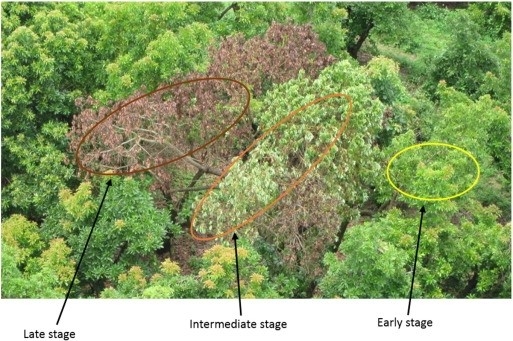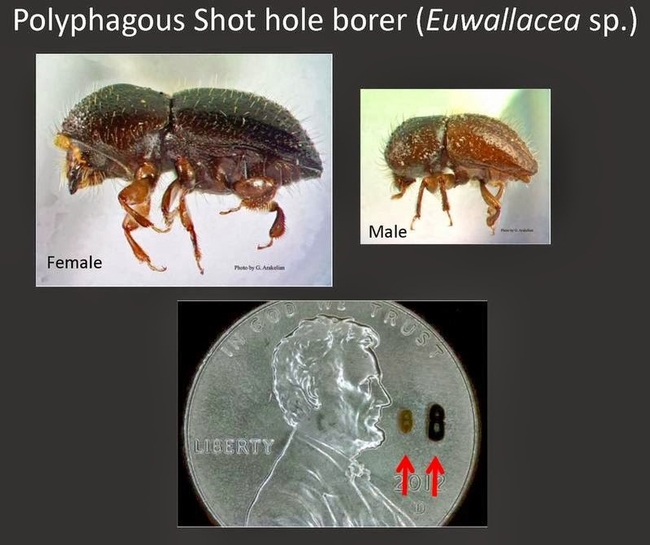
Posts Tagged: ambrosia beetles
Avocado and Laurel Wilt Webinar and CEUs
Next up on Ag Experts Talking is Laurel Wilt Disease which is causing major damage in the native tree populations of the south east United States and the avocado groves in particular. Learn what is being done there and what the potential threat is to California avocados.
What Are the UC Ag Experts Talking About?
What is involved in the webinars?
A series of 1 hour webinars, designed for growers and Pest Control Advisors, will highlight various pest management and horticultural topics for citrus and avocados. During each session, a UC Expert on the subject will make a presentation and entertain write-in questions via chat during and/or after the presentation. As we develop this program, we may expand to other crops.
Topics: pests and diseases of citrus, avocado and other crops
What are the topics and how do I register?
Laurel Wilt (March 20, 2019 from 3-4 pm)
Dr. Monique J. Rivera will present current knowledge of the laurel wilt, the biology and ecology of its vector - Ambrosia beetles, current known location of the disease in the US, Identifying the disease, and the laurel wilt disease prevention in California.Dr. Monique J. Rivera will present current knowledge of the laurel wilt, its biology and spreading. One DPR CE unit (other) and one CCA CE unit (IPM) are pending.
Register:
https://ucanr.edu/sites/ucexpertstalk/?calitem=439527&g=103975
Management of Glyphosate-Resistant Weeds in Orchard Crops (April 24, 2019 from 3-4pm)
Dr. Brad Hanson, cooperative extension specialist, will discuss what is herbicide resistance, current state of resistant weeds in CA permanent crops, identification and lifecycle of key glyphosate-resistant weeds, selection pressure for resistant biotypes and species, herbicide modes of action, and examples of herbicide programs for orchard crops. One DPR CE unit (other) and one CCA CE unit (IPM) are pending.
Register:
https://ucanr.edu/sites/ucexpertstalk/?calitem=439496&g=103975
Are there Continuing Education units?
When the subject discusses pest or disease management, continuing education units will be requested from DPR (1 unit per session). Participants will pre-register, participate in the webinar and be awarded the unit. The sessions will be recorded and hosted on this web site for future study. However, continuing education units will be awarded only to the participants who attend the live version of the webinar.
Who is involved?
This webinar series is brought to you by Ben Faber (UC ANR Ventura Advisor) and Dr. Beth Grafton-Cardwell (Depart of Entomology UC Riverside Extension Specialist) with the technical support of Petr Kosina (UC IPM Contect Development Supervisor) and Cheryl Reynolds (UC IPM Interactive Learning Developer).

laurel wilt stages (2)
Polyphagous Shot Hole Borer: San Diego Population Now Known as Kuroshio Shot Hole Borer
Through DNA sequencing, UCR entomologist have determined that we have two separate invasions of the Polyphagous Shot Hole Borer (PSHB) here in southern California attacking avocados. One invasion in San Diego County and the second in Los Angeles County. UCR entomologist, Richard Stouthamer states the two are different species genetically, but morphologically they are indistinguishable, luckily they both respond to the same lure. They do however carry different fungal symbionts with them.
The species that has invaded San Diego, is now known as the Kuroshio shot hole borer, and is originally found only in two places in the presumed native range: highlands of Taiwan and in Okinawa. The species of beetle that has invaded Los Angeles County will now be known solely as the Polyphagous, its native range is in Vietnam, South China, North Thailand, low lands of Taiwan and Okinawa, this species has also invaded Israel and South Africa.
These Shot Hole Bores are Ambrosia beetles, a specialized group belonging to the family Scolytidae. The shot hole borer was first found in Whittier Narrows in Los Angeles County in 2003. From 2003-2010 the beetle was found on a few ornamental trees, then in 2010 it was the presumptive cause of the death of a large number of box elder street trees in Long Beach. In 2012 the beetle was collected from a backyard avocado tree in South Gate, and from several tree species at local botanical gardens, since then it has been causing havoc in the avocado industry. It now appears to be established in Los Angeles, Orange, San Bernardino and Riverside Counties, and is expanding its range in San Diego County. A single beetle was caught in Santa Cruz County in 2014 and has now been found less than 2 miles from Ventura County line.
The beetle is dark brown to black and tiny, with females between 0.07 and 0.1 inches long, and males even smaller, usually about 0.05 inches long. They differ from the bark beetles in this family in several ways. While bark beetles burrow in the phloem layer or at the juncture of the bark and sapwood, ambrosia beetles bore through the bark and into the sapwood. The shot hole bores are highly specialized and feed on fungi that they cultivate on the walls of the tunnels. In the case of the shot hole bores, they transport the pathogenic fungus, Fusarium euwallacea and both the adults and larvae feed on the fungus.
Shot hole borers attacks hundreds of tree species, but it can only successfully lay its eggs and/or grow the fungi in certain hosts. These include: Avocado, Box elder, California sycamore, Coast live oak, White alder, Japanese maple, and Red willow. Visit http://eskalenlab.ucr.edu/ for the full list. Infection with the fungus can cause a dry or wet and oily dark stain surrounding the entry holes, discolored wood, leaf discoloration and wilting, and dieback of entire branches. In box elders and avocados, a while crusty ring of sugar, also called a “sugar volcano” can be produced. Frass (wood dust left behind from boring) may be produced, but because this can quickly dissolve if it rains it can be missed sometimes. If the barked is scraped away, dark dead tissue may be found around the galleries.
Currently there is no cure for the fungus once the tree has become infected. Chipping and solarizing/tarping infested wood can help to limit the spread of the beetle/fungus. Wood should be chipped to pieces smaller than 1". Don't forget to sterilize pruning tools between uses to avoid spreading the fungus.
If you suspect you may have the shot hole bore in your grove please feel free to contact your local CE Farm Advisor/Specialist.
PSHB Look Alikes
As we continue an historic drought in California, trees all over Southern California are showing symptoms of stress, and in some cases have died due to drought and pests that attack drought stressed trees. Despite recent and significant rainstorms, it is likely that trees will again be stressed later in the irrigation season. Trees and other woody plants in nurseries also bear the burden of drought stress as irrigation waters become increasingly salty because of drought effects on wells and reliance on stored water in reservoirs continues.
The Polyphagous shot hole borer is a serious pest of nursery and landscape trees and threatens many species. As such, counties adjacent to Los Angeles are at risk of invasion by this new exotic pest and we are watching and monitoring trees for possible extant new detections. The drought has stressed many of the signature trees that could be attacked by PSHB and these trees are often attacked by native or established pests. In some cases these beetles closely resemble PSHB and cause symtpoms of bleeding and in some cases cambial discoloration and gallery formation similar to that of PSHB.
On coast live oak (Quercus agrifolia) there are two look alike beetles the western oak bark beetle (Pseudopityophthorus pubipenis) and the Oak ambrosia beetle (Monarthrum scutellare). The western oak bark beetle is common in Southern California and the ambrosia beetle more common in the northern half of the state but both have been detected throughout California. As with many beetle/tree interactions both of these are attracted to drought stressed trees. When attacked coast live oak bleeds heavily and these insects often attack in larger numbers uniformly along the main stems or trunk. Examination of the cambium of Oak Bark Beetle attacked trees reveals small galleries and little or no necrotic tissue.
Prunus spp such as peach, nectarine, plum and apricot are common in back yards and retail nurseries. This year we are seeing much increased attack of these trees by the European fruit borer or shot hole borer (Scolytus rugulosus) a beetle very similar in stature to PSHB. The insect is the same size as PSHB and makes numerous holes and causes excessive bleeding in Prunus. This insect also seems to carry a fungal pathogen resulting in cambial necrosis.
One other insect that could be mistaken for PSHB is the walnut twig borer which vectors Thousand Cankers Disease of walnuts (both native and English). This beetle (Pityophthorus juglandis) carries with it a fungus Geosmithia morbida, that causes extensive cambial necrosis, and ultimately twig and branch dieback results from its presence.

PSHB damage


